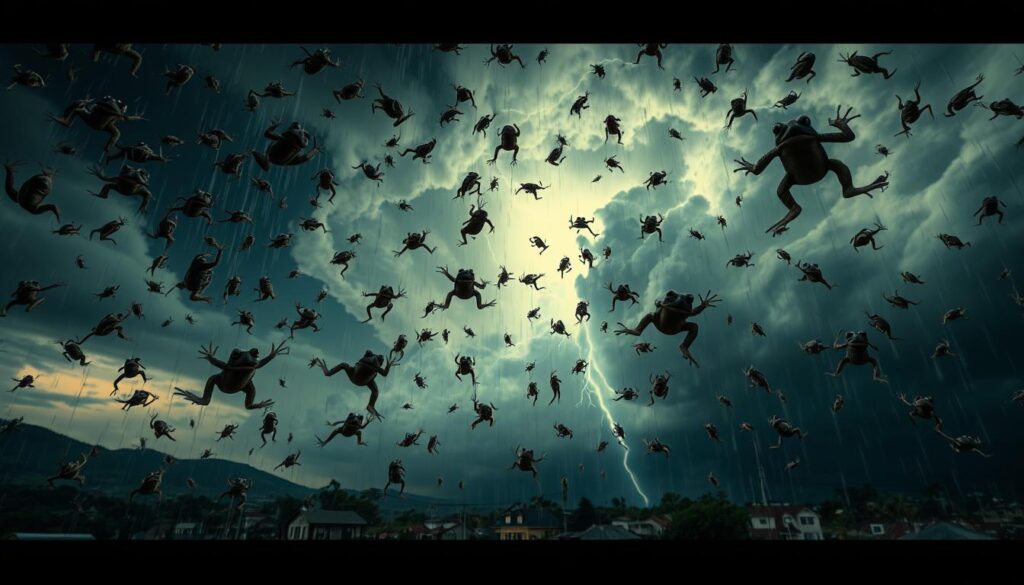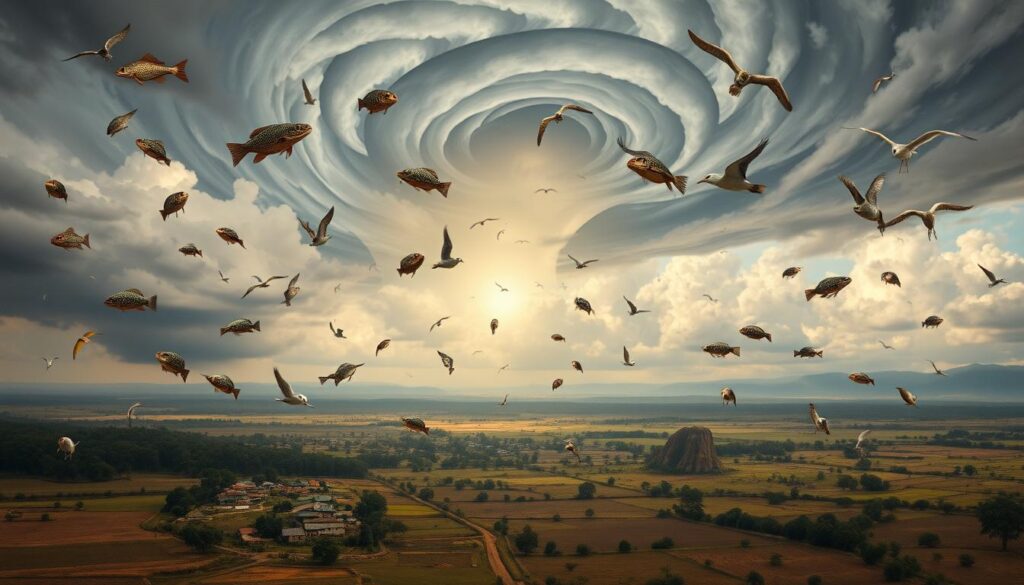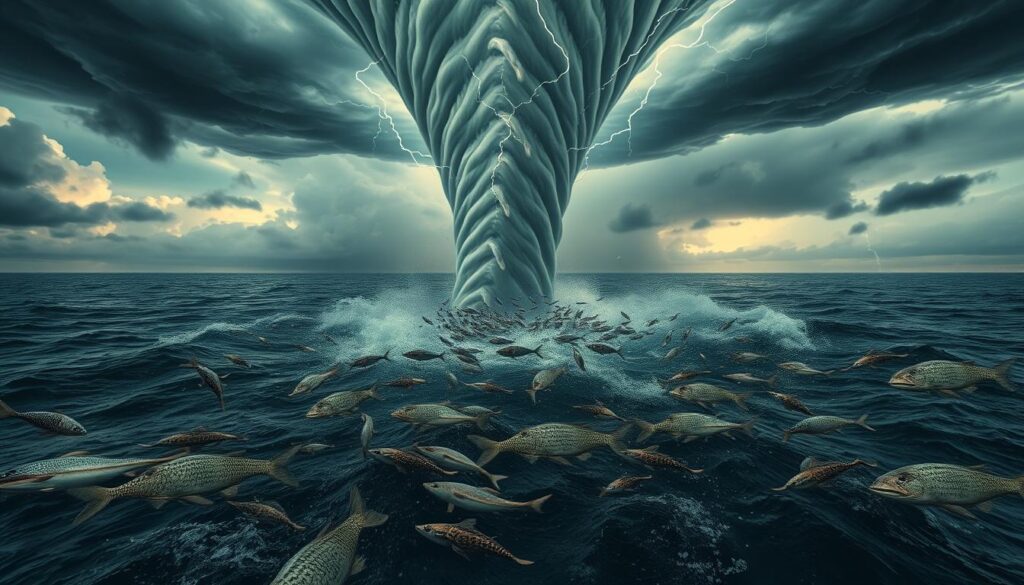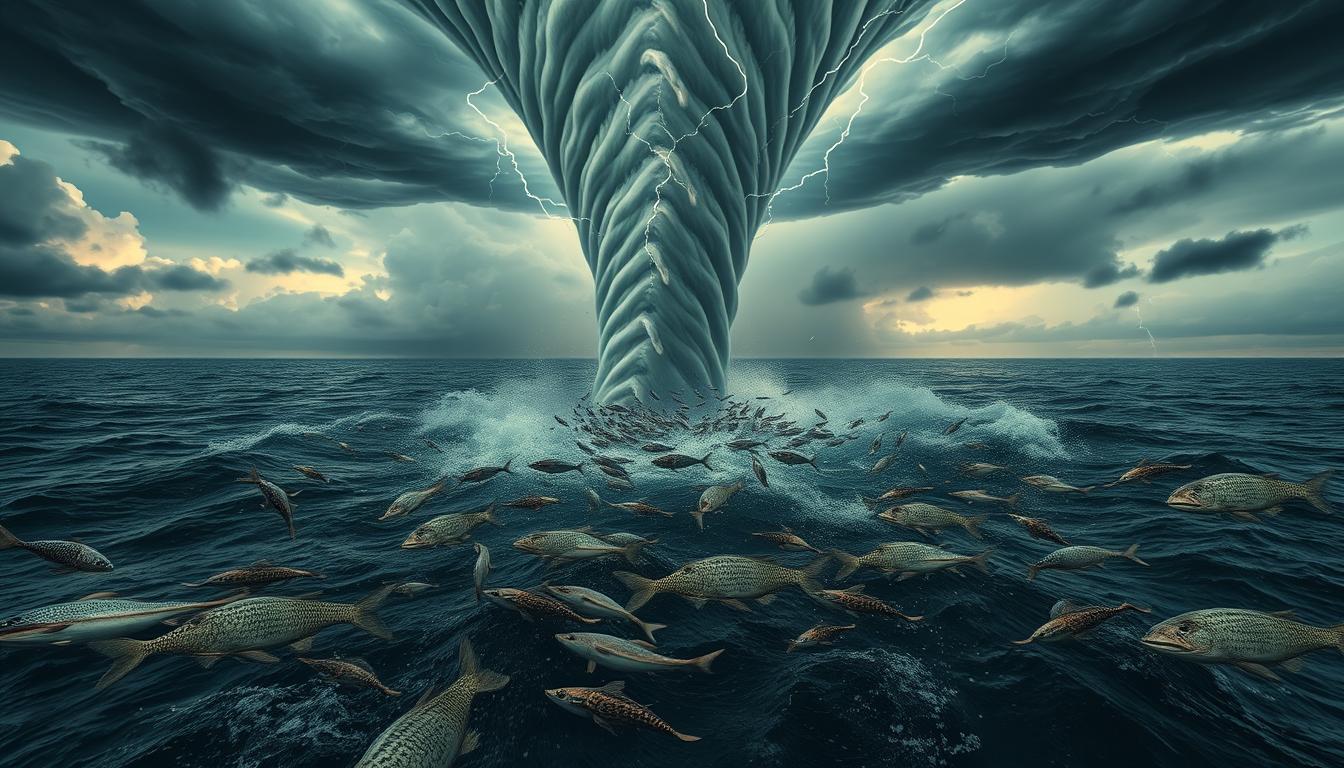Imagine walking down the street and frogs start falling from the sky. It sounds like something from science fiction. But the animal rain phenomenon has been a mystery for centuries. Is it real, or just a myth passed down through generations?
Reports of fish, frogs, and even snakes raining from clear skies come from all over the world. This has left many wondering if it’s true.

Strange weather events like animal rain challenge our understanding of nature. Scientists have found cases where small creatures seem to fall from the sky during storms. In Yoro, Honduras, locals celebrate an annual “rain of fish” that they say has happened for over a century.
In 2022, people in Texarkana, Texas, were shocked when fish fell from the sky during a storm in December.
The truth behind these events is a mix of meteorology, biology, and how we see things. As we explore this strange world, we’ll look at the facts and possible reasons for this weird weather.
Key Takeaways Animal Rain
- Animal rain has been reported throughout history across multiple continents
- Fish and frogs are the most commonly reported animals in these strange weather events
- Scientific explanations often involve waterspouts and strong wind patterns
- The Yoro “rain of fish” in Honduras is among the most famous recurring cases
- Modern meteorologists have verified several recent animal rain incidents
- Many reports can be explained by natural weather phenomena rather than supernatural causes
The Mysterious Phenomenon
The skies open up, and rain pours down. People start dodging falling fish, frogs, or other small creatures. This strange event, called animal rain, has puzzled scientists and amazed people for centuries. It has been reported from almost every continent, showing it knows no cultural bounds.
What Exactly Is Animal Rain?
Animal rain happens when small animals fall from the sky during rain. It usually involves fish and frogs, but sometimes worms, snails, and even small birds. These animals are often alive but seem disoriented, spread out in certain areas after rainstorms.
First Documented Occurrences
The history goes back a long way. Roman writer Pliny the Elder wrote about fish falling from the sky in his “Natural History” around 77 CE. Athenaeus of Naucratis also described a rain of fish lasting three days in the 3rd century. These old stories are similar to today’s reports, showing it isn’t just a new wonder.
Common Misconceptions
Many think it is a hoax or mistaken identity. But science has shown it’s real. Another myth is that animals magically appear in clouds. The truth is, animals aren’t created in the sky. Instead, natural events can lift them up. Fish and frogs don’t swim or hop through clouds on their own.
Historical Accounts Through the Ages
People have been fascinated by it for thousands of years. Roman writer Pliny the Elder wrote about fish falling from the sky in his book “Natural History” around 77 CE. This is one of the earliest known it history stories. Many saw these events as signs from the gods.
Ancient Greek thinkers tried to explain these mysteries. Aristotle thought frogs didn’t fall from the sky but came out of mud after rain. But, many eyewitnesses disagreed with this idea.
In the Middle Ages, Europe saw many historical animal rain accounts. In 1355, a big storm in Basel, Switzerland brought down perch, pike, and other fish. Church leaders believed these storms were messages from God.
The Enlightenment brought more scientific study. In 1804, French scientist André-Marie Ampère collected stories of frogs falling from the sky. By the 19th century, newspapers shared both old and new ancient animal rain records together.
| Time Period | Location | Animals Reported | Notable Documentation |
|---|---|---|---|
| 77 CE | Roman Empire | Fish | Pliny’s Natural History |
| 1355 | Basel, Switzerland | Freshwater fish | Town chronicles |
| 1804 | Lalande, France | Frogs | Ampère’s scientific notes |
| 1857 | Mountain Ash, Wales | Small fish | Illustrated London News |
Different cultures saw animal rain in different ways. Chinese texts from the Tang Dynasty saw fish showers as good luck. Japanese records, however, saw frog rain as a warning of disasters.
Does Animal Rain Really Happen? The Scientific Evidence
For centuries, people have talked about animal rain. But does it really happen? Today, scientists are studying this phenomenon. They say animal rain is a rare event with its own rules.
Modern Documented Cases
In 2005, thousands of frogs fell from the sky in Serbia. Scientists found they were local frogs. In 2010, hundreds of perch fell in Australia, linked to a waterspout.
In Honduras, fish rain happens often. National Geographic studied it in 1970. This lets scientists study it closely.
Laboratory Studies and Research
Scientists have been studying animal rain. They’ve tested how small animals can survive in the air. Frogs and fish can handle cold and low pressure, like at high altitudes.
| Research Focus | Key Findings |
|---|---|
| Animal survival in transport | Small frogs can survive up to 30 minutes at altitudes of 1,000+ meters |
| Waterspout lifting capacity | F1 waterspouts can lift objects weighing up to 3 pounds |
| Pattern analysis | 96% of confirmed cases occur near bodies of water during storm formation |
Expert Opinions from Meteorologists
Meteorologists say animal rain is possible. They explain it through weather science. Waterspouts and updrafts can pick up animals from water and drop them elsewhere.
The French meteorological society studied animal rain for five years. They looked at 34 cases and confirmed 28. They found a link between weather conditions and animal rain.
Famous Cases of Animal Rain Worldwide
History is full of animal rain events that amazed people and scientists. These cases show that animal rain happens all over the world, in different places and weather. They are fascinating and have caught the attention of many.

The Yoro Fish Rain in Honduras
In Honduras, Yoro is known for its famous fish rain. Since the 1860s, people have seen “Lluvia de Peces,” or fish rain. It happens every year from May to July.
This event is so important that Yoro has a festival to celebrate it. It’s a unique event that draws people from everywhere.
Frog Downpours in Japan
In Japan, frog rain has happened many times, especially in rural areas. In Nanao City, a big frog rain happened in June 2009. Hundreds of small frogs fell during a storm.
People were amazed to see frogs everywhere. It was a mystery to scientists, but they confirmed it was real.
“I was driving when suddenly hundreds of tiny frogs began hitting my windshield. It was like nothing I had ever seen before – the road was literally covered in them.”
Recent Incidents in the United States
California and Louisiana have seen animal rain in the last ten years. In 2017, Oroville, California, saw tiny fish fall during a storm. This surprised everyone.
In Texarkana, Texas, a fish rain in December 2021 made headlines. Social media was filled with pictures of small shad after a storm.
Types of Animals Reported in Rain Events
Not all animals in rain phenomena are the same. Fish are the most common in animal rain events around the world. They are small, usually between one to four inches long, and light enough to be carried by strong winds.
Frogs and tadpoles are the second most common raining animals. Their small size and love for water make them easy to lift into the air. Many people have seen hundreds of tiny frogs on streets and yards after rain.
- Small crustaceans like shrimp and crayfish
- Worms and earthworms
- Spiders and insects
- Small birds, though much rarer
- Jellyfish, reported in Bath, England in 1894
The weight of an animal is key in these weather events. Heavier animals are less likely to be lifted into the air. This is why we rarely hear of big animals falling from the sky. But tiny fish or frogs can be explained by science.
The Meteorological Connection: How Weather Creates Animal Rain
When animals fall from the sky, science points to specific weather patterns as the primary culprit. The connection between unusual precipitation and atmospheric conditions offers logical explanations for these bizarre occurrences. Understanding the meteorological forces behind animal rain helps separate myth from scientific reality.
Waterspouts and Tornadic Activity
The waterspout theory stands as the most credible explanation for animal rain phenomena. These rotating columns of air form over bodies of water, creating powerful vacuum effects. They can lift small creatures into the atmosphere.
Waterspouts can generate wind speeds exceeding 100 mph. This is enough force to suck up fish, frogs, and other small animals from lakes, ponds, or shallow coastal waters.

The Transport and Deposition Process
Once lifted into the air, animals become unwilling passengers in atmospheric currents. The transport mechanism relies on strong updrafts. These can carry creatures several miles from their original location.
These animals remain aloft until weather conditions change. Typically, this happens when rain forms and gravity pulls them back to earth. This explains why animal rain causes tend to concentrate the fallen creatures in small areas rather than scattering them widely.
Weather Conditions That Favor Animal Rain
Specific weather anomalies create ideal conditions for animal rainfall. These include:
- Warm surface water temperatures that encourage waterspout formation
- Unstable atmospheric conditions with significant temperature differences
- Convergent wind patterns that concentrate the falling creatures
- Storm systems that move from water bodies over land
Research shows that seasonal transitions often trigger these unique conditions. This is especially true in coastal regions where warm water and cool air interact. Weather radar has occasionally captured evidence of these anomalous patterns. This provides further support for the waterspout theory as the primary mechanism behind animal rain events.
Cultural Impact and Folklore Surrounding Animal Rain
Strange rains of animals have shaped beliefs and stories across human cultures for centuries. The sight of fish, frogs, or birds falling from the sky naturally sparks wonder and demands explanation.
Religious Interpretations Throughout History
Many cultures view animal rain as divine messages. In ancient Egypt, frog rains were linked to the goddess Heqet. Biblical accounts describe the plague of frogs as divine punishment. Norse animal rain folklore connected such events to the anger of Thor, and similar patterns exist in Asian and African traditions.
Native American tribes developed unique cultural animal rain beliefs. They often saw these occurrences as sacred gifts during times of hunger or as warnings from nature spirits.
Animal Rain in Literature and Film
Creative minds have long found inspiration in this strange weather phenomenon. Classic works like Márquez’s One Hundred Years of Solitude feature magical fish rains. The film “Magnolia” uses frog rain as a powerful symbolic climax.
“And then it started to rain toads. Yes, toads. Small ones. Thousands of them. The street was thick with them.” – From “The Toad Rain Chronicles,” a popular 1940s radio drama that captured public fascination with the phenomenon.
Modern television shows frequently reference this phenomenon. Documentary series explore historical cases. Science fiction programs imagine apocalyptic scenarios. The persistent presence of animal rain in media shows how deeply this natural oddity has penetrated our collective imagination.
Debunked Myths and Misidentified Cases
Not every report of animals falling from the sky is true. The Singapore fish rain of 1861 is a famous hoax. Journalists made up the story to sell more papers. It spread all over the world before anyone doubted it.
Social media makes fake animal rain stories spread fast. In 2022, a video of frogs raining in Beijing went viral. But experts found it was faked. The person behind it got many followers before confessing.
Natural events can look like animal rain. In 2015, thousands of worms showed up on a Norwegian sidewalk. People thought it was a “worm rain.” But scientists said flooding just brought the worms to the surface.
Animal behavior can also lead to mistaken animal rain reports. When frogs migrate after rain, it looks like they fell from the sky. They hide during dry times and come out together after storms. This makes people think they saw animal rain.
It’s important to check the facts of animal rain reports. Real animal rain needs special weather and certain animals. Today, scientists use radar, examine specimens, and talk to witnesses to tell real from fake.
Conclusion: Separating Fact from Fiction in Animal Rain Phenomena
Our journey into the world of animal rain has shown us the blend of science and myths. It’s true that animals falling from the sky might sound like a dream. Yet, animal rain is real, though it’s rare and not well understood.
Studies and documented cases prove that animal rain happens. It’s explained by natural events like waterspouts and tornadoes. But, some stories might be wrong or made up. The excitement of the unusual can lead to mistakes.
As we finish our look at animal rain, we value the mysteries of our world more. This strange event reminds us of how much we still don’t know. By being curious and critical, we can learn more and clear up myths about animal rain.
FAQ
What is animal rain?
Animal rain is a rare weather event. It happens when small creatures like fish or frogs seem to fall from the sky. This usually occurs during or after a rainstorm.
Has animal rain been documented throughout history?
Yes, animal rain has been reported for centuries. Some of the first records come from ancient and medieval times.
What are the common misconceptions about animal rain?
Many people think animals just magically appear in the clouds. Others believe all stories of animal rain are fake. But scientists have proven it’s real.
What types of animals have been reported in rain events?
Fish and frogs are the most common animals found in rain. But, worms, spiders, birds, and even bigger animals have been reported too.
How do weather conditions create animal rain?
Scientists think waterspouts and tornados can lift small animals into the air. Then, when it rains, these animals fall back to the ground.
Are all reports of animal rain legitimate?
No, not every story of animal rain is true. Some are hoaxes or misidentifications. It’s key to check the facts before believing them.
Does animal rain really happen?
Yes, animal rain is real. It’s been studied and explained by science. While some stories might be too good to be true, the evidence shows it does happen, but it’s rare.
Source link
